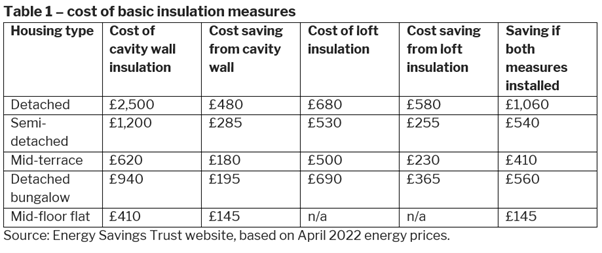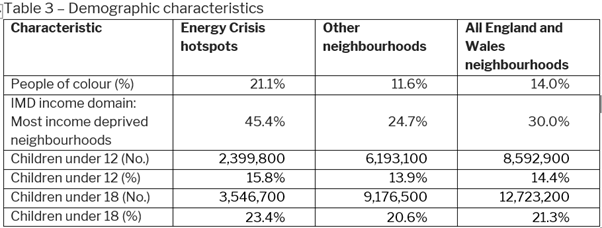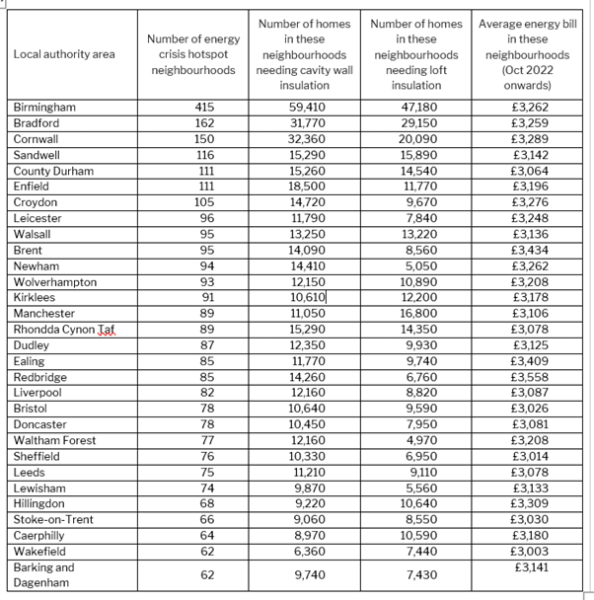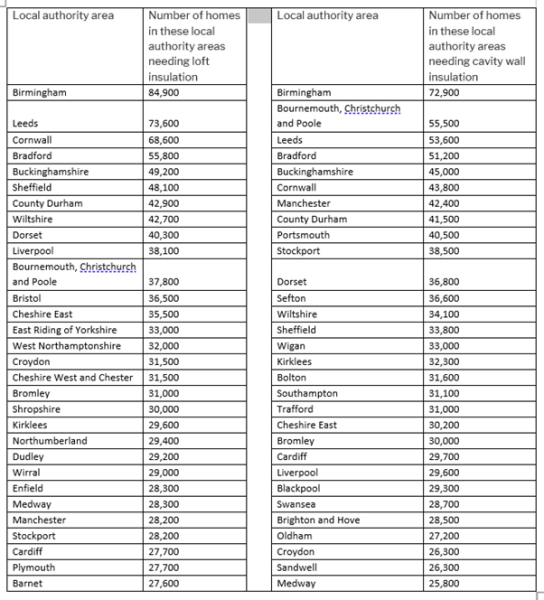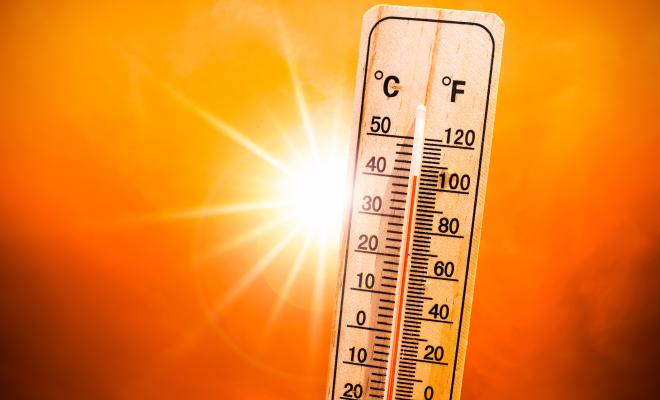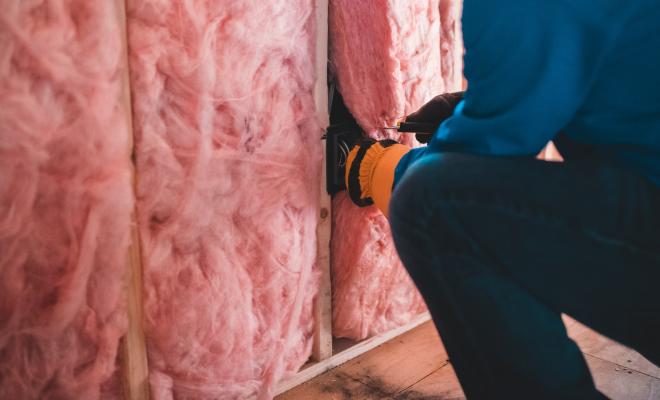Mike Childs22 Aug 2022
Summary
The energy crisis has exposed the appalling energy efficiency of the UK’s housing stock. Those living in poorly insulated homes will feel the cost of energy more than others and renters are on the frontline, hit both by the poorest housing stock and fast rising rents.
Free energy saving measures
In England, Friends of the Earth is calling for a rapid programme of free basic energy saving measures which should be council-led, delivered street-by-street and funded by the government. They should include loft and cavity wall insulation, draught-proofing, thermostatic radiator valves, smart heating controls and energy audits - targeting those neighbourhoods most in need first.
Energy crisis hotspots
Friends of the Earth has identified 8,927 "energy crisis hotspots" in England and Wales - the neighbourhoods with lower than average income but higher than average energy use (according to data from smart meters). These neighbourhoods have a higher proportion of children and twice the proportion of people of colour living in them than other neighbourhoods.
In Wales, where local authorities are smaller and less resourced, we are calling for an area-by-area retrofit programme to be funded through the Welsh Warm Homes Programme.
The housing stock in the UK is amongst the worst in Europe.
4.4 million homes in England and Wales are still without cavity wall insulation and 4.8 million homes without loft insulation. Using the Energy Performance Certificates database, Friends of the Earth has identified how many of these are in each energy crisis hotspot, as well as the number in whole local authority areas.
Programme costs
Research by the New Economics Foundation for Friends of the Earth has calculated that the cost for a household receiving these basic energy saving measures varies depending on house type, from around £1,300 to £2,500, with a saving every year of around £490 to £720. The cost of this programme for a local authority with very poor levels of insulation – modelled on Blackpool –would be £54 million.
An England and Wales programme would cost around £15 billion, to be spent over the period needed to roll out the measures. The investment would save households three times that in energy costs over a ten-year period (dependent on future energy costs).
Saving energy, cutting carbon emissions and levelling up
Friends of the Earth is calling for this programme to be kick-started using the Energy Profits Levy / Windfall Levy introduced by the Government in May (which is expected to raise £5 billion a year but could raise a lot more if strengthened). As well as being a very socially progressive programme, it would also be a significant contribution to carbon emission reduction goals and levelling-up.
Cost of living crisis
When Ofgem announces the October increase to the energy cap, typical energy prices will have risen by almost £2,000 from a year ago, increasing to £3,244 from £1,277 in October 2021. The rise is equal to £164 extra expenditure per month. It is an 154% increase in 12 months. There is speculation that this could even rise to a frightening £3,850 in January 2023.
Energy is not the only cost rising. The average rent has increased by 11% over the last year, almost reaching £1,000 a month, and costs are rising at the fastest rate for 14 years. By contrast, the average mortgage repayment is £790 a month. Renters are on the frontline of the cost-of-living crisis. Food price inflation is also expected to peak at 15% this summer. In this context Friends of the Earth supports financial support for the people most impacted by the cost of living crisis.
But one of the reasons why energy price increases hurt so much is due to the poor insulation of the the UK’s housing stock. Urgent action is needed to address this issue.
Targeted street-by-street insulation programmes
With sky high energy prices and the need for rapid action to insulate homes, it is also important to recognise that many people can’t afford the upfront cost of insulation and may not be able to do so for some years to come (the duration of high energy costs is very uncertain).
Friends of the Earth is therefore calling for the government to fund councils in England to roll-out a free street-by-street programme of installing basic insulation measures, targeting the neighbourhoods most in need first. Research led by the UK Collaborative Centre for Housing Evidence, based at the University of Sheffield, found that street-by-street programmes increased participation in insulation programmes, brought cost savings through economies of scale, and built trust in the improvements being made. We are also proposing that every household is given a free energy audit to identify how they can further reduce energy use and cut carbon emissions. In Wales, the Welsh Warm Homes Programme should fund an area-by-area approach.
Neighbourhoods most in need
Data analysis by Friends of the Earth has identified energy crisis hotspots - the neighbourhoods in England and Wales most in need of support, Using data on actual energy consumption and data on income, it has been possible to identify those neighbourhoods that have less than average incomes but higher than average energy bills. There are 8,927 of these neighbourhoods (26 per cent of the total number) and 15.2 million people live within them.
The five local authorities with the greatest number of these neighbourhoods are Birmingham, Bradford, Cornwall, Sandwell, and County Durham and the five local authorities with the highest proportion of these neighbourhoods are Fenland, Blaenau Gwent, Birmingham, Merthyr Tydfil, and Bolsover (a top 25 listing is provided in Appendix 1 and a full data set of all local authorities is here).
In addition, we have identified the type of tenure within these neighbourhoods (owner-occupied or rental), the existing level of energy efficiency, and the proportion of homes that would benefit from loft and/or cavity wall insulation. This additional analysis can also inform targeting and the response needed.
The data sources for this analysis are listed in Appendix 3.
Who pays?
We are calling for this to be a universal benefit for all households, regardless of wealth or tenure, initially funded by the Windfall Tax/Energy Profits Levy on fossil-fuel companies. Means-testing would create additional bureaucracy and potentially conflict within neighbourhoods between those that receive the benefit and those that don’t.
While in ordinary circumstances it might be reasonable to ask householders to make at least some contribution to the cost of basic insulation measures because there will be savings on their energy bill, we are not living in ordinary times. As the table below shows, the cost savings from these measures are still far less than the increases in energy bills seen over the last year.
The government has switched its cash support for energy bills from a loan to a grant. Friends of the Earth believes a similar free programme of basic insulation is the correct approach in these unusual times.
Cost of basic insulation measures
Source: Energy Savings Trust website, based on April 2022 energy prices.
Programme costs
The New Economics Foundation (NEF) has estimated the cost of this free programme of energy savings measures (loft and cavity wall insulation, draught-proofing, thermostatic radiator valves, and smart heating controls) combined with a free energy audit, for a local authority area modelled on Blackpool. They estimate the cost to be £54 million pounds. Every house in Blackpool would get a free energy audit and those that need it the other measures.
41% of homes in Blackpool need cavity wall insulation (28,900) and 22.4% need loft insulation (15,800), based on an analysis by Friends of the Earth of Energy Performance Certificates. It has the second highest proportion of homes in England and Wales needing cavity wall insulation and the 45th for loft insulation. It is in the bottom 5% of local authority areas for the proportion of homes that are well insulated (EPC C), meaning it would be one of the areas of highest cost for the programme.
The total cost for England and Wales will therefore not be as high as an extrapolation of the Blackpool costs, which would be £19 billion. A figure of around £15 billion seems more likely1. For practical reasons, these costs will be spread out over several years.
The Energy Profits Levy/Windfall Levy, as currently operated, is expected to raise £5 billion per year. A higher rate tax without exemptions to encourage more oil and gas exploration could raise £13 billion per year.
Private-rented sector
The private-rented sector has the greatest levels of fuel poverty. Based on pre-energy crisis data (2020) it has a 25% rate of fuel poverty compared to 18.7% in social homes and 8.4% in owner-occupied homes. Levels will be much higher now given the dramatic increase in energy prices (and in the rental sector due to soaring rents).
Theoretically there are regulations which require the very worst private-sector homes to be insulated to at least EPC E-rated, but these are poorly enforced by councils. Bureaucratic hurdles set by government and a lack of finances make it difficult for councils to enforce these, but some councils, such as Liverpool, are succeeding. But a property at EPC E is still a very poorly insulated home. In 2020 the government consulted on requiring all private-rented homes to reach EPC C by 2028 (well insulated) but has still failed to make final decisions and lay new regulations.
Friends of the Earth believes that landlords should also benefit from a universal programme of free basic energy saving measures. This is because tenants will be the winners, even though it could be said to benefit landlords who are already profiting from poorly insulated homes.
Who benefits?
Everybody benefits from a universal programme of free basic insulation measures. But those that benefit most will be those neighbourhoods that are prioritised– the most in need.
Appendix 1 identifies where these neighbourhoods are mostly located (by number of neighbourhoods by local authority area) and an online map identifies the location of these.
The individual householders that will most benefit will be those that receive free cavity wall and/or loft insulation. Appendix 2 provides the top 30 local authority areas for the number of homes that would receive free loft insulation and/or free cavity wall insulation (the full dataset is available here).
Areas most benefiting from a free energy saving programme
Demographic characteristics
Deeper retrofits
The New Economics Foundation report for Friends of the Earth also estimated the costs of deeper retrofits (measures such as internal or external wall insulation, floor insulation, installation of heat pumps, solar panels, etc and excluding the cost of the basic measures the free programme would deliver). For an area like Blackpool, they suggested the cost would be something like £986 million (average £14,000 per household in the area) with a £34 million annual saving in energy costs. This would bring homes in the areas to a very high standard of insulation. It was not possible to calculate from this a figure for England and Wales without further analysis, as the costs will vary considerably between areas for measures such as wall insulation, dependent on the age profile of the local housing.
Estimates of the cost of deeper retrofits of homes vary significantly. The Climate Change Committee has previously estimated a cost of £55 billion for retrofitting domestic housing to a good level (EPC C), but this excludes the cost of fitting heat pumps. Others have suggested the cost could be £300-£500 billion, including heat pumps. If the Blackpool costs were extrapolated to the whole of England and Wales, the cost would be £347 billion. But these higher figures need to be treated with extreme caution because innovation (e.g., much cheaper heat pumps), scale, and efficiency saving from a large-scale retrofit programme could reduce the cost substantially.
In our view, a programme of deeper retrofits should also be led by local authorities, as a second stage after a first stage of basic energy saving and energy audits. The energy audits offered in the first stage would be important preparatory work for stage two.
If fuel poverty is to be eliminated and legally binding climate change reduction targets are to be met, it is essential that this programme is properly funded..
NEF’s report suggests that a blend of grant and payment is one way of funding at least part of this. The research suggests that if householders contributed to the cost of this deeper retrofit programme with a 2% interest loan paid through 50% of the expected energy bill saving, the cost to the Treasury would reduce by around a quarter (dependent on future energy prices). The grant element of this, funded by government, would therefore be in the order of 75% of the costs.
The report also explores alternative methods for funding this deeper retrofit. And some of the measures needed may be met through regulations with no recourse to the public purse, such as standards for the private rented sector or minimum efficiency standards before a property may be sold.
This infrastructure programme must be a priority, regardless of the option or options chosen..
Conclusion
The energy crisis is driving millions more people into fuel poverty. Fuel poverty group National Energy Action (NEA) say that as much as 8.5 million households could be in fuel poverty this winter, equal to 1 in 3 households, who will need to choose between heat or food. Renters will continue to be in the frontline, as they will also need to pay increasingly high rents, while mortgage-owners may be able to work with their bank to reschedule payments. The financial support provided to householders by the government is very welcome, but more will be needed.
Funding energy saving programmes must be part of the response and will also reduce carbon emissions which are fuelling extreme weather in the UK and across the globe. A rapid street-by-street programme of free basic energy saving measures is cost effective and efficient. It will be a progressive measure that will also contribute to the government’s levelling-up agenda.
Appendix 1 Numbers of energy crisis hotspot neighbourhoods (low income and high energy use) by local authority in England and Wales (top 30)
Appendix 2 Numbers of homes by local authority needing loft insulation and cavity wall insulation (top 30)
Appendix 3 Data sources and methodology
Analysis approach
Friends of the Earth has conducted some analysis to calculating average fuel costs across all neighbourhoods in England and Wales using statistics on heating fuel use, energy consumption, energy efficiency and the latest fuel price rises. This included national statistics on electricity and mains gas consumption, as well as estimated consumption of unmetered fuels such as heating oil, LPG and biomass.
The results from this analysis combined with neighbourhood level data on income deprivation from the English Indices of Deprivation and Welsh Index of Multiple Deprivation (WIMD) to identify neighbourhoods most in need in the energy crisis: those with above average energy costs and below average incomes.
Further statistics on energy efficiency of homes and housing tenure were then used to segment these most in need neighbourhoods into three distinct priority groups: those with a high proportion of poorly insulated rental properties which would most benefit from higher rental standards.; those with a high proportion of poorly insulated owner-occupier homes which would benefit from a free street-by-street insulation programme; and those which have a high proportion of well-insulated properties which would benefit most with financial support. These account for approximately 25% of all neighbourhoods. (The remaining 75% of neighbourhoods will also need support, and beyond this rapid targeted response to the energy crisis, Friends of the Earth wants to see all areas benefit from better insulation and being powered with clean, cheap, renewable energy.)
Data sources
The data sources used in the analysis described above were:
EPCs: Domestic Energy Performance Certificate (EPC) data; Source: Department for Levelling Up, Housing & Communities (DLUHC).
Mains gas and electricity energy consumption:
-
Sub-regional electricity consumption statistics; Source: Department of Business Energy and Industrial Strategy (BEIS).
-
Sub-regional gas consumption statistics; Source: BEIS.
Electricity and mains gas fuel price statistics; Source: BEIS.
Impact of energy price cap rise on crisis on electricity and mains gas fuel prices; Source: The Energy Shop.
Unmetered fuel prices (LPG, heating oil, coal and biomass); Source: Sutherland Tables.
English Indices of Deprivation; Source: Ministry of Housing, Communities & Local Government (MHCLG).
Welsh Index of Multiple Deprivation; Source: Welsh Government.
Lower Super Output Area mid-year population estimates (used to show population by age band); Source: ONS.
Household tenure by Lower Super Output Area; Source: ONS/Census 2011.
Ethnic Group by Lower Super Output Area; Source: ONS/Census 2011.
All data sources are licenced under the Open Government Licence 3.
- 1The costs of a national programme are very uncertain until learnings from piloting a programme are discovered but a ballpark estimate can be made. We’ve looked at national data on homes needing cavity wall or loft insulation and with assumptions on draught-proofing, TRVs the figure comes to £13.7 billion, excluding cost of smart controls and energy audits. Alternatively, the average cost per home in Blackpool is £764 for the programme (many homes will not need all the basic measures, and some will not need any). 95% of other local authority areas in England and Wales have better insulated homes. So, if this average cost across England and Wales is £600 the total cost is £14.8 billion whereas if it is £500 the cost is £12.4 billion. £15 billion therefore seems a reasonable estimate.



